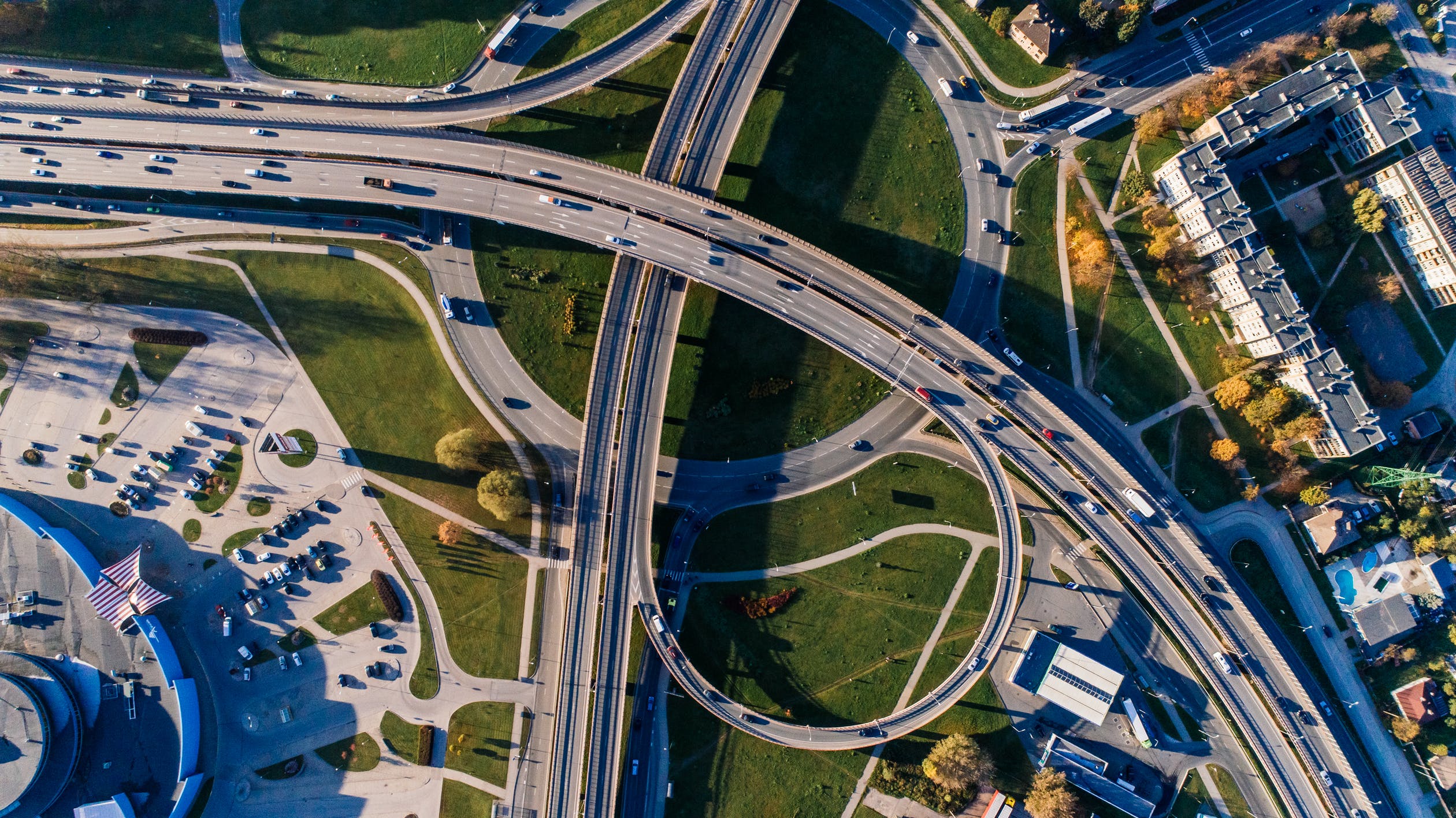Way back in the 19th century, as motorized vehicles unlocked opportunities for travel and economic expansion, engineers explored many different methods to build the sturdy roads we needed to support rapid economic growth. They laid the first asphalt pavement in Newark, New Jersey in 1870 using a sand mix, and placed the first instance of Portland Cement Concrete (PCC) in Rochester, New York in 1893. The next year, they placed a different configuration of PCC in Bellefontaine, Ohio. While the Bellefontaine pavement is still in use and was even recognized for its durability by the American Concrete Pavement Association on its centennial anniversary, the Rochester roadway experienced irregular cracking within its first two years of life. That failure led to one of many cause-and-effect innovations in roadway construction: the first instance of PCC overlay with asphalt in 1896.
Over the next 80 years, engineers compared the virtues of flexible asphalt pavement with rigid concrete pavement in different conditions. They experimented with slab thickness, width and length and tested surfaces like brick, granite, wood blocks and concrete for stability. They incorporated dowels and tested various configurations of slab cross sections, jointing and reinforcement schemes. They subjected different pavement sections to heavy army truck traffic and studied how different materials supported load transfers.
| What makes something resilient? |
|
Resilience is often synonymous with toughness in multiple applications. According to the Federal Highway Administration, resilience is "the ability to anticipate, prepare for, and adapt to changing conditions and withstand, respond to, and recover rapidly from disruptions." Resilient people ignore criticism and from their extended family on Facebook and report lower levels of anxiety. Resilient roads handle increasing traffic volumes for longer than current design standards and require less long-term maintenance. |
In 1958, just after the federal highway system was authorized by Congress, the American Association of State Highway Officials initiated the groundbreaking Road Test experiment, which yielded the most comprehensive pavement data to date. From there, the American Association of State Highway and Transportation Officials (AASHTO) published Pavement Design Procedures and began applying them to roadway projects across the country. The success of this study led to the formation of the Federal Highway Administration’s Long-Term Pavement Performance Program (LTPP) which focuses on determining why some pavements perform better than others in various conditions.
By 1977, engineers were leaning into new technology to build the best pavements and computerizing their research. By the 1980s, they were collaborating globally, reducing duplicative efforts and incorporating new materials into roadway construction to yield better results. They soon discovered that by using polymeric materials beneath traditional construction aggregate, they were able to extend the stability and longevity of roadways in both paved and unpaved roadway applications – while using less materials overall. These technological advancements held huge promise for the future of roadway construction, and engineers embarked upon the 21st century eager to put all their research in to practice in the form of better, longer-lasting roads.
Roadblocks to longevity
With data collected from years of testing pavement performance variables, modern day engineers honor the legacy of their predecessors by devising innovative solutions and materials to make roads last longer than ever before.
But then – we can only assume – they put those innovative solutions in a folder on their laptops labeled “Cool Stuff That’s Never Going to Happen Unless Legislators Stop Making It So Damn Hard.” It’s a cynical labeling system, but it’s honest. We have more expertise to improve roadway resiliency than ever before, but current policies make it nearly impossible to put them into practice.
In fact, flawed U.S. procurement policies and rigid contracting procedures actively discourage innovation at the expense of roadway resiliency. In many states, DOTs select contractors who guarantee the fastest delivery at the lowest costs – with no stipulations for pavement performance and longevity. Others expressly prohibit the use of emerging technologies. They are wary of challenging the “this is the way we’ve always done it” mentality that keep agencies across the country mired in mediocrity at the expense of progress. Restricted by policies that limit engineers and contractors from trying new methodologies, many do not want to be seen as disruptors by trying a new approach and risk their chance at securing steady reconstruction work.
Organizations like the ARTBA have made progress in challenging restrictive policies by continuously advocating for infrastructure investments and policies that are representative of the nation’s need for safe and efficient travel. In 2018, ARTBA petitioned USDOT to repeal a 103-year-old rule that prohibited state and local governments from using patented or proprietary products on highway and bridge projects – and saw its repeal the following year. Of the victory, ARTBA President and CEO Dave Bauer challenged the nation to advocate for change by saying, “The status quo should never be an acceptable goal. The full repeal of an archaic rule will help open the marketplace to a wave of innovative products aimed at improving motorist safety and more efficiently delivering transportation improvements both the public and private sectors agree are necessary.”
And while ARTBA and other lobbyists are making slow progress on repealing restrictive rulings, they still struggle with changing bureaucratic perception that pavement performance should not be included as a decision factor in procurement. It’s short-sighted, but it’s also increasingly frustrating because we know that performance-based procurement stipulations are not only possible, they also deliver safer, longer-lasting, cost-efficient roadways. Because they’ve been doing it in Europe for years.
Across the pond, governments prioritize long-term road lifecycle performance over costs in contractual negotiations by dictating how long a highway should last under which environmental and traffic conditions, and letting contractors determine the best method to deliver to those requirements. In the U.S., contractors must comply with strict specifications for materials and procedures but are not held responsible for guaranteeing the road’s lifecycle performance. American contractors simply do not have the motivation or flexibility to deliver longer lasting roadway products outside of focused contract scopes.
Many American officials advocate for a switch to a performance-based procurement system like we see in Europe, but face opposition from lawyers and builders who do not want to guarantee the life-span of their products in the face of changing traffic conditions. Though Europeans make these roadway product guarantees with proven results, Americans operate under the misconception that to build roads better, they must use more materials and spend more money. But with new technology, we don’t need more materials to build roads better – we just need different materials. Other countries have supplemented conventional roadway materials with geosynthetics to increase roadway longevity without a greater investment. Geosynthetics stabilize rock and asphalt materials, so that roadways require less materials overall. Often, this approach results in lower initial investment and lower pavement lifecycle repair costs than traditional construction methods. And because less materials require less travel to the construction site, the carbon footprint of these types of roadway innovations make construction more-efficient, cost-effective and sustainable. These materials and other innovative technologies are already available in the U.S., but their adoption remains limited.
The real cost of deteriorating roadways
In 1956, the Highway Trust Fund was the coolest thing since sliced bread when it planned and funded the sprawling construction of our national roadway system and helped America solidify its economic powerhouse status. But nearly seven decades later, we have greatly exceeded the intended lifespan of this vast network, and we’re paying the price. Without any intervention to build roads that last longer in the first place, the country is hemorrhaging $28 billion each year just to repair them – without any thought to making them last longer – and sacrificing even more in terms of lost time, traffic delays, accidents and fatalities. The congestion and accidents caused by deteriorating road conditions cost the country nearly $120 billion and cause 38,000 highway fatalities each year. Failing infrastructure is also responsible for a staggering 6.9 billion hours wasted in traffic. These costs represent huge opportunities for improvement, and we should be exploring every possible avenue to address them. But we just keep falling short.
In December of 2015, Obama signed the first federal law in over a decade to provide long-term funding for surface transportation infrastructure planning and development. The Fixing America’s Surface Transportation (FAST) Act allocated $305 billion over five years for a broad range of highway, rail, public transportation, safety and research initiatives – with less than 0.0001% allocated for the delivery of new innovations and technologies to benefit highway transportation. It’s a classic example of “failing to plan is planning to fail” in action, as the oversight has created huge cost implications for the country, states, local governments and motorists.
With the FAST Act set to expire in September 2020, lawmakers are at odds about the focus of a successive bill to improve the country’s infrastructure, and innovation continues to be a point of contention. When the House proposed $1.5 trillion for infrastructure improvements that challenge the status quo, strengthen our transportation network and offer increased sustainability, the Senate denounced the effort as “pointless political theater.” The infighting provides yet another obstacle to innovation and progress.
Where we're going, we do need roads
While evolution of roadway technology is largely anecdotal prior to the computerization of record-keeping in 1977, we learned a lot about how to strengthen transportation network in the past 150 years. And we narrowed down the best solutions to pursue in the next 150 years and beyond. We just need to evolve our outdated procurement practices to match.
With extensive research, we abandoned practices and materials that didn’t demonstrate clear longevity in roadway lifetimes – like decreased slab thickness – and pursued materials and technology that demonstrated the most resiliency against the constant crush of increasing traffic volume and loads – like asphalt and geosynthetics. With annual award recognition of roadways that last longer than the expected roadway design life of 20 years, we started celebrating what works in roadway technology and encouraging contractors and agencies to pursue similar longevity in new roadway projects where they can.
We now know a lot about the materials and conditions that make roads last longer. But to reap the rewards of this knowledge, we need to continue emphasizing the economic and social benefits of long-lasting roadways so that agencies mandate long-lasting road performance outcomes. And we need to build on the momentum of 200 years of roadway research and re-invigorate the collaborative spirit of early roadway construction breakthroughs. We don’t need to wait for a catastrophic highway failures to implement innovative technologies today that will take us where we need to go in the future.






Comment